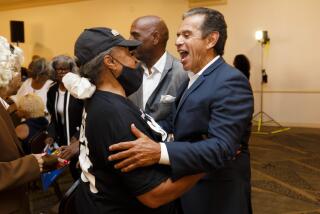N.Y. to L.A.: Ya Gotta [heart] Bratton
- Share via
It’s only natural for new Los Angeles Mayor Antonio Villaraigosa to look to New York for examples of urban success and failure. In his campaign, he repeatedly invoked the name of New York’s Depression-era Mayor Fiorello LaGuardia, his favorite politician. The LaGuardia “little New Deal” for Gotham that excites Villaraigosa’s political imagination owed much to the New York mayor’s partnership with President Franklin D. Roosevelt and the Democratic majorities in Congress that wanted to use the city as a proving ground for New Deal policies. Today’s suburban-dominated Congress precludes any such partnership for Villaraigosa, but he can learn much from the experiences of New York mayors, especially from Gotham’s last two mayors, David Dinkins and Rudolph Giuliani.
At first glance, Villaraigosa has more in common with the former. Dinkins was elected a year after Jesse Jackson’s celebrated 1988 presidential run and was seen by liberals as their best hope for a political revival during the George H.W. Bush White House years. Political analysts said his election as New York’s first black mayor represented a “new racial and political ascendancy.” But under the pressure of enormous expectations, Dinkins made several major mistakes.
First, the mayor spent a lot of time in Washington seeking solutions to his city’s problems and advancing the national liberal agenda -- and failed on both counts. Dinkins placed enormous hopes in Bill Clinton’s election to the presidency, but Washington, he discovered painfully, was still stacked against the cities.
Like Villaraigosa, Dinkins was every kind of liberal. He had close ties with Gotham’s unions, civil liberties organizations, homeless activists and big-business liberals in the movie and real estate industries. Like Villaraigosa, Dinkins wanted to help small business. But he also believed, like Villaraigosa, that big government and big economic interests should join to set policy, which usually hurts the small entrepreneurs who account for almost all urban job growth. Confronted by this and other tensions between his constituencies, Dinkins zigzagged his way into indecision.
But for all his shifts, Dinkins never budged from his belief in “root causes” of crime, which undergirded his conviction that policing could have, at best, only a marginal effect on crime.
Although Villaraigosa and Giuliani hail from different portions of the political spectrum, both are high-energy and ambitious leaders who took strikingly similar paths to power. Both were narrowly defeated the first time they ran, and both spent the next four years preparing to govern. Both won their rematches by defeating lackluster incumbents ineffective at using the bully pulpit. Dinkins and James K. Hahn belonged to the old order and were unable to capitalize on the enhanced power granted to them by changes in their respective city charters.
Giuliani exploited the new powers of the New York mayoralty, mastering the workings of the municipal bureaucracy to make the ungovernable city at least temporarily governable. Villaraigosa’s command of policy detail is open to question, but he is moving to exercise the power Hahn had declined by effectively taking control of the Metropolitan Transportation Authority.
The most important lesson Villaraigosa can take from Giuliani is that an investment in policing is an investment in the economy. In New York, the decline in robbery and mayhem reduced the crime tax on small business and struggling entrepreneurs even as it revived struggling neighborhoods.
It’s Villaraigosa’s great good fortune that he can take advantage, as Giuliani did, of the extraordinary talents of William Bratton. Giuliani, who took office in the midst of a fiscal crisis, gave Bratton, his police commissioner, the wherewithal to reduce crime sharply. In L.A., the most under-policed major city in the U.S., Villaraigosa can give Bratton, his police chief, the resources he lacks to tackle the city’s highly organized gangs. “Give me 3,000 more cops,” Bratton has said, “and I’ll make this the safest city in America in two years.”
Villaraigosa should take him at his word and pour some of his growing sales and property tax revenue into the Los Angeles Police Department. As Bob Hertzberg, chairman of Villaraigosa’s transition team, pointed out, city revenues have grown by 14% since 2001-02 while police spending has increased by a mere 1.9%. In Gotham, Bratton, given the resources, produced the sharpest sustained drops in crime since the FBI began keeping crime statistics in the early 1930s and, subsequently, he also presided over the sharpest rise in home values in its poorest neighborhoods.
Occidental College political science professor Peter Dreier says Villaraigosa will be “judged by his civic housekeeping. His record at home will be what can propel him onto a larger stage.”
Should Bratton’s success once again cast his mayor into the national spotlight, Villaraigosa should avoid Giuliani’s biggest mistake. Unwilling to share the crime-fighting glory, the former New York mayor fired his finest appointment. But the danger for Villaraigosa is likely to come from a controversial incident involving the police -- such as the recent killing a 19-month-old girl during a shootout with her father in Watts. The mayor has so far handled the crisis deftly, attending the little girl’s funeral while standing resolutely behind the police. The test for Villaraigosa will come if the shooting investigation’s conclusions pit his American Civil Liberties Union allegiances against the imperatives of policing.
More to Read
Get the L.A. Times Politics newsletter
Deeply reported insights into legislation, politics and policy from Sacramento, Washington and beyond. In your inbox twice per week.
You may occasionally receive promotional content from the Los Angeles Times.










